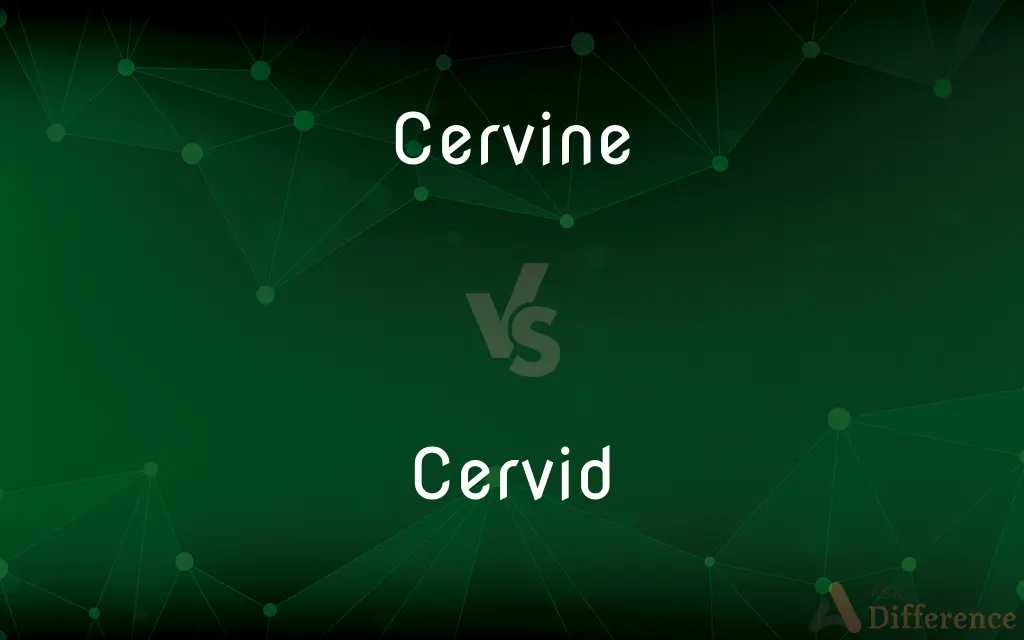Cervine vs. Cervid — What's the Difference?
By Fiza Rafique & Maham Liaqat — Updated on April 26, 2024
Cervine refers to attributes resembling deer, focusing on qualities and characteristics, whereas cervid pertains specifically to members of the deer family itself.

Difference Between Cervine and Cervid
Table of Contents
ADVERTISEMENT
Key Differences
Cervine describes characteristics or qualities that are deer-like, capturing the essence of how something appears or behaves in relation to deer. On the other hand, cervid is a taxonomic term used to denote any animal belonging to the family Cervidae, which includes all species of deer.
When discussing the adjective "cervine," it is often used in contexts that emphasize similarity to deer in aspects like gracefulness or physical features. Whereas "cervid" strictly categorizes actual deer species, such as moose, elk, and reindeer, identifying them as part of a biological family.
In literature or descriptive writing, cervine might be employed to enhance the imagery of a scene by comparing elements to deer. Conversely, cervid would be used in scientific or academic discussions focusing on zoology and wildlife studies, where precise classification is crucial.
Cervine can apply to things that are not deer but possess deer-like attributes, such as certain movements or appearances. On the other hand, cervid cannot be applied metaphorically; it is used exclusively for animals that are scientifically classified as deer.
While cervine captures a more poetic or symbolic usage, appealing to those interested in artistic or literary descriptions, cervid appeals to biologists and those studying wildlife, offering a clear, scientific categorization of these animals.
ADVERTISEMENT
Comparison Chart
Definition
Resembling deer
A member of the deer family
Usage
Descriptive, often metaphorical
Scientific, taxonomic
Applicability
Qualities and characteristics
Actual animals
Example Context
Literary descriptions
Biological classifications
Non-Applicable Use
Cannot classify animals
Not used for describing non-deer
Compare with Definitions
Cervine
Deer-like in essence or form.
The forest had a cervine silence, serene and alert.
Cervid
Pertains to deer as defined in biological classification.
The cervid display at the museum features antlers from various species.
Cervine
Resembling deer in appearance or behavior.
The delicate, cervine grace of the dancer was mesmerizing.
Cervid
Belonging to the taxonomic group of deer.
Moose are the largest cervid in North America.
Cervine
Pertaining to deer-like characteristics.
The cervine features of the sculpture made it a favorite in the garden.
Cervid
Referring to any deer species scientifically.
Cervid research focuses on the habitats and behaviors of these animals.
Cervine
Having qualities that evoke the idea of deer.
Her cervine movements made her stand out in the ballet.
Cervid
A member of the family Cervidae, which includes deer.
The park is home to several cervid species, including elk and white-tailed deer.
Cervine
Relating to deer in a metaphorical sense.
The poet described the morning as cervine, gentle and cautious.
Cervid
Classified under the deer family in zoology.
The study examines cervid migration patterns.
Cervine
Relating to deer; deerlike.
Cervid
A mammal of the deer family (Cervidae ).
Cervine
Relating to, resembling, or characteristic of deer.
Cervid
Any of various hoofed mammals of the family Cervidae, which includes the deer, moose, and elk. Most male cervids grow antlers that are shed each year.
Cervine
Of or belonging to the family Cervidae, which includes the deer, moose, and elk.
Cervid
(zoology) Any animal (such as the deer) of the family Cervidae
Cervine
Pertaining to a deer; deer-like.
Cervid
Any member of the family Cervidae, a type of deer distinguished from the Bovidae by the male's having solid deciduous antlers.
Cervine
A deer of the subfamily Cervinae; an Old World deer.
Cervid
Distinguished from Bovidae by the male's having solid deciduous antlers
Cervine
Of or pertaining to the deer, or to the family Cervidæ.
Cervine
Relating to or resembling deer
Common Curiosities
Are there any cervine animals other than deer?
While "cervine" describes characteristics similar to deer, it does not refer to specific animals but to qualities that are deer-like.
What role do cervids play in their ecosystems?
Cervids play crucial roles in their ecosystems as browsers and grazers, affecting forest regeneration and plant diversity.
How are cervids classified scientifically?
Cervids belong to the family Cervidae in the order Artiodactyla, which includes all types of deer.
Can the term cervine be used in describing plants?
Yes, cervine can be metaphorically used to describe plants that have delicate, slender forms reminiscent of deer.
What is the origin of the term "cervine"?
Cervine is derived from the Latin word "cervinus," which means "of deer."
Is cervine ever used in scientific classifications?
Cervine is not used for scientific classifications; it is purely descriptive and metaphorical.
What adaptations do cervids have for their environment?
Cervids have adapted with camouflage, acute senses, and sometimes aquatic skills (like the moose) to thrive in diverse habitats.
What common features define cervids?
Common features of cervids include the presence of antlers (in most male species), hooved feet, and a ruminant digestive system.
Can cervine describe behavior?
Yes, cervine can describe behavior that is timid, graceful, or alert, much like that of deer.
How is cervine typically used in art or literature?
In art or literature, cervine is used to convey elegance, grace, or timidity, often drawing comparisons to deer.
Which continents are cervids found on?
Cervids are found on all continents except Antarctica, with species adapted to a wide range of habitats from tundra to tropical forests.
Do all cervids have antlers?
Most male cervids grow antlers that are shed and regrown annually, except for the Chinese water deer, which have tusks instead.
Are cervids considered keystone species?
In many environments, cervids are considered keystone species due to their impact on vegetation and the way their foraging habits influence other wildlife and plant growth.
What is the largest cervid?
The moose is the largest cervid, known for its massive body size and distinctive antlers.
How does cervine differ in usage from similar terms like "bovine" or "canine"?
Cervine specifically evokes deer-like qualities, while bovine relates to cows and canine to dogs, each emphasizing attributes typical of those animals.
Share Your Discovery

Previous Comparison
Spanker vs. Spankee
Next Comparison
Check vs. ChequeAuthor Spotlight
Written by
Fiza RafiqueFiza Rafique is a skilled content writer at AskDifference.com, where she meticulously refines and enhances written pieces. Drawing from her vast editorial expertise, Fiza ensures clarity, accuracy, and precision in every article. Passionate about language, she continually seeks to elevate the quality of content for readers worldwide.
Co-written by
Maham Liaqat















































